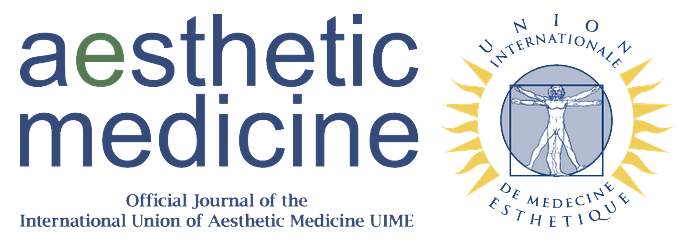Progressive treatment of lower third of the face laxity using different forms of poly-1-lactic acid (PLLA), from a solution to threads
Keywords:
skin quality,, skin laxity, polylactic acid, suspension threads, lower third, PLLA threadsAbstract
Background: Treating ageing in the lower third of the face focuses on restoring volume and correcting the position of the subcutaneous tissue (SC). Among the various injectable substances used for volume restoration, PLLA (poly-1-lactic acid) has proven to be effective as a collagen biostimulator and can be used to correct both shallow and deep nasolabial fold contour deficiencies as well as other wrinkles. Once the SC volume has been restored, suspension threads can be used for an even more effective repositioning of the SC. Aim: In this study we present the findings of using an injective PLLA solution and PLLA suspension threads for an optimal treatment, aiming to combat sagging in the lower third of the face, combining neocollagenesis and mechanical tissue repositioning. Methods: Between February 2020 and January 2022, 23 patients with sagging in the lower third of the face were selected to undergo combined therapy using an injected solution of PLLA and a thread-lift using PLLA suspension threads. The injection of PLLA was carried out three times, once a month. One month after the last PLLA injection, PLLA threads were inserted. Results: At a 12-month follow-up, all 23 patients presented a more defined jawline, an improvement in the distribution of volume in the lower third, and an increased skin toning, as well as a long-lasting lifting effect. There were no short or long-term complications. Conclusions: The reshaping of the lower third using a combination of a biostimulatory solution of PLLA and a PLLA suspension thread-lift is a safe, effective and long lasting therapy. It is worth noting that the final outcome of the acid treatment depends on a careful facial analysis that is necessary to determine the appropriate treatment.
References
Swift A, Liew S, Weinkle S, Garcia JK, Silberberg MB. The Facial Aging Process From the "Inside Out". Aesthet Surg J. 2021; 41(10):1107-1119.
Lamb J. Volume rejuvenation of the face. Mo Med. 2010; 107(3):198-202.
Van Dongen JA, Harmsen MC, Stevens HP, van der Lei B. Facial Lipofilling: A Difference Between Volume Restoration and Tissue Rejuvenation. Aesthet Surg J. 2021; 41(9):NP1247-NP1248.
Goldberg DJ. Stimulation of collagenesis by poly-L-lactic acid (PLLA) and -glycolide polymer (PLGA)-containing absorbable suspension suture and parallel sustained clinical benefit. J Cosmet Dermatol. 2020; 19(5):1172-1178.
Atiyeh BS, Chahine F, Ghanem OA. Percutaneous Thread Lift Facial Rejuvenation: Literature Review and Evidence-Based Analysis. Aesthetic Plast Surg. 2021; 45(4):1540-1550.
Carruthers A, Carruthers J. A validated facial grading scale: the future of facial ageing measurement tools? J Cosmet Laser Ther. 2010; 12(5):235-41.
Hanke CW, Redbord KP. Safety and efficacy of poly-L-lactic acid in HIV lipoatrophy and lipoatrophy of aging. J Drugs Dermatol. 2007; 6(2):123-8.
Ray S, Adelnia H, Ta HT. Collagen and the effect of poly-l-lactic acid based materials on its synthesis. Biomater Sci. 2021; 9(17):5714-5731.
Hamilton DG, Gauthier N, Robertson BF. Late-onset, recurrent facial nodules associated with injection of poly-L-lactic acid. Dermatol Surg. 2008; 34(1):123-6.
Apikian M, Roberts S, Goodman GJ. Adverse reactions to polylactic acid injections in the periorbital area. J Cosmet Dermatol. 2007; 6(2):95-101.
Palm M, Weinkle S, Cho Y, LaTowsky B, Prather H. A Randomized Study on PLLA Using Higher Dilution Volume and Immediate Use Following Reconstitution. J Drugs Dermatol. 2021; 20(7):760-766.
Chen SY, Chen ST, Lin JY, Lin CY. Reconstitution of Injectable Poly-d,l-lactic Acid: Efficacy of Different Diluents and a New Accelerating Method. Plast Reconstr Surg Glob Open. 2020; 8(5):e2829.
Zhang Y, Liang H, Luo Q, et al. In vivo inducing collagen regeneration of biodegradable polymer microspheres. Regen Biomater. 2021; 15;8(5):rbab042.
Lu H, Oh HH, Kawazoe N, Yamagishi K, Chen G. PLLA-collagen and PLLA-gelatin hybrid scaffolds with funnel-like porous structure for skin tissue engineering. Sci Technol Adv Mater. 2012; 13(6):064210.
Convery C, Davies E, Murray G, Walker L. Delayed-onset Nodules (DONs) and Considering their Treatment following use of Hyaluronic Acid (HA) Fillers. J Clin Aesthet Dermatol. 2021; 14(7):E59-E67.
Bauer U, Graivier MH. Optimizing injectable poly-L-lactic acid administration for soft tissue augmentation: The rationale for three treatment sessions. Can J Plast Surg. 2011; 19(3):e22-7.
Downloads
Published
Issue
Section
License
Copyright (c) 2023 Enrico Massidda, Annalisa Calisti

This work is licensed under a Creative Commons Attribution-NonCommercial 4.0 International License.
This is an Open Access article distributed under the terms of the Creative Commons Attribution License (https://creativecommons.org/licenses/by-nc/4.0) which permits unrestricted use, distribution, and reproduction in any medium, provided the original work is properly cited.
Transfer of Copyright and Permission to Reproduce Parts of Published Papers.
Authors retain the copyright for their published work. No formal permission will be required to reproduce parts (tables or illustrations) of published papers, provided the source is quoted appropriately and reproduction has no commercial intent. Reproductions with commercial intent will require written permission and payment of royalties.

This work is licensed under a Creative Commons Attribution-NonCommercial 4.0 International License.





